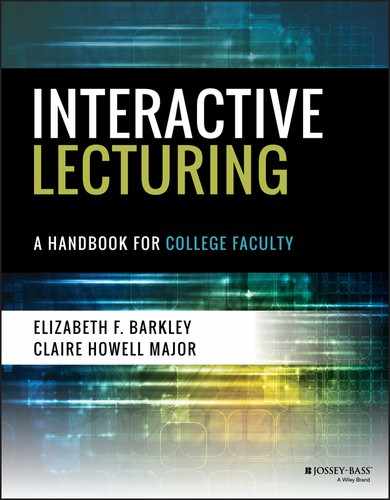ENGAGING LECTURE TIP 48
Wait Time
Research demonstrates that when a teacher poses a question in a typical college class session, he or she typically waits for less than one second before calling on someone. There are significant challenges to this practice. In particular, any responses you get cannot be very well thought out. In addition, you are likely to get the same students responding over and over—those who think fast or those who are extroverted enough to be comfortable with thinking on the fly. Moreover, this practice can promote inequities in the classroom because male students—particularly white male students—tend to speak in response more than female or minority students (Mintz, n.d.).
Increasing the Wait Time, a concept created by Rowe in the 1970s, improves responses. Wait Time is the time between a question and an answer. The idea is to wait at least three to seven seconds to get a lengthier response, a more technically correct response, a better-quality response, and a wider variety of responses. You will also likely get more volunteers and fewer students who respond with “I don't know.” Allowing sufficient Wait Time is particularly important when the questions are substantive and high level, requiring thoughtful responses.
Stahl (1994) recommends several different types of think time or Wait Time, some of which we have adapted as follows:
- Post-teacher question Wait Time. The professor pauses for a few seconds before taking responses. This Wait Time provides students with sufficient uninterrupted time to first consider and then respond to the question. Lemov (2010) suggests that you may wish to provide some guidance during this time (e.g., “I'd like to see a few more hands before taking responses.” “I'd like to see a few hands from people who haven't had a chance to participate yet today.” “I see some people jotting down ideas. This is a great idea. I'll wait a few more seconds so that people can finish.”)
- Post-student response Wait Time. The class waits for a few seconds of uninterrupted silence after a student has responded and considers offering their reactions, comments, or answers in response to the first student. This Wait Time provides other students with sufficient time to think and decide whether they want to say something of their own.
- Post-student question Wait Time. Teacher pause time is characterized by the teacher taking a few seconds of uninterrupted silence to deliberately consider how to respond to a student question or comment. Teachers need time to think, too.
- Post-teacher response Wait Time. The class waits for a few seconds of uninterrupted silence after the professor has responded to a student question. Students consider volunteering their reactions, comments, or answers in response. This Wait Time provides students with an opportunity to think and decide whether they want to contribute something of their own.
The silence of the wait period will likely feel uncomfortable. There is also a trick on finding exactly how long to wait because too long will cause discomfort and too short will not yield the desired results. Practiced well, however, Wait Time can greatly improve responses.
Example
Key References and Resources
- Lemov, D. (2010). Teach like a champion: 49 strategies that put students on the path to success. San Francisco, CA: Jossey-Bass.
- Mintz, S. (n.d.). Gender issues in the college classroom. Retrieved from www.columbia.edu/cu/tat/pdfs/gender.pdf
- Rowe, M. B. (1987). Wait time: Slowing down may be a way of speeding up. American Educator, 11(1), 38–43.
- Stahl, R. (1994). Using “think-time” and “wait-time” skillfully in the classroom. ERIC Digest. Retrieved from http://files.eric.ed.gov/fulltext/ED370885.pdf
